1lumen selects and reviews products personally. We may earn affiliate commissions through our links, which help support our testing.
Cyansky H5GT review
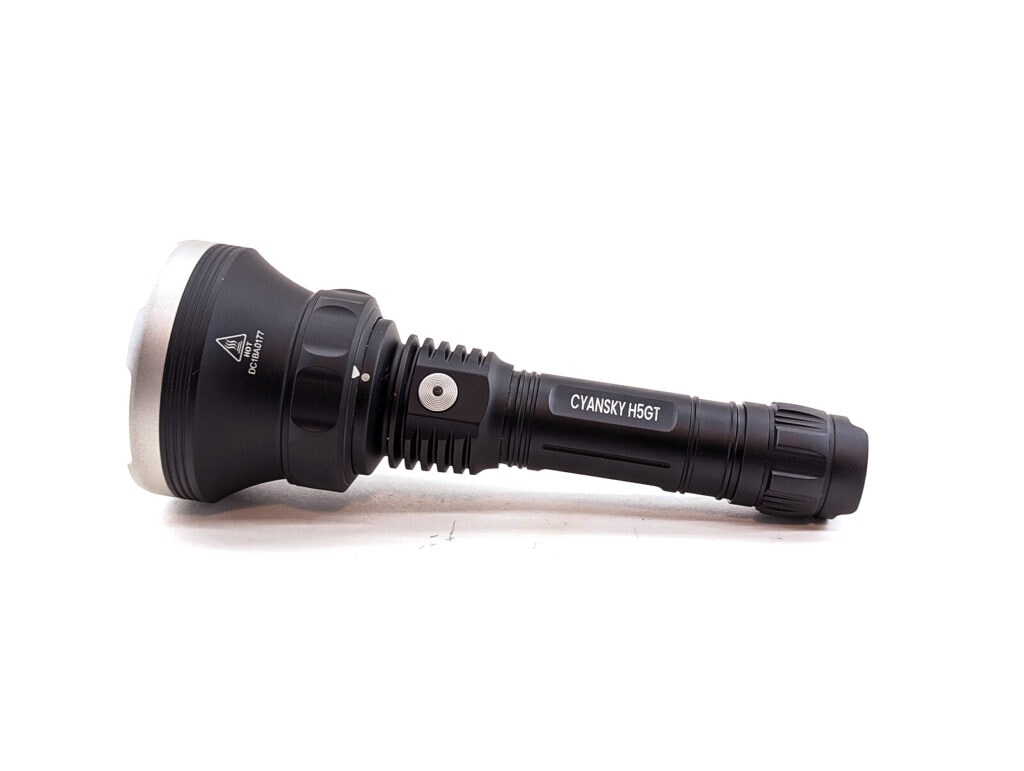
Cyansky H5GT specs
| Brand & Model | Cyansky H5GT |
|---|---|
| Flashlight category | Hunting, long-range flashlight |
| LED | Luminus SFT40 (white), Luminus SFT20 (colors) |
| Max. output | 2,000 lumens (white) |
| Max. beam distance | 1,000 meters (white) |
| Max. beam intensity | 250,000 cd (white) |
| Battery config. | 1x 21700 |
| Onboard charging | No (built into the battery) |
| Main modes | 4 |
| Blinkies | N/A |
| Waterproof | IP68 |
| Review publication date | September 2023 |
Review intro:
Note: the H5GT has been updated. The one we reviewed was the earlier version with a 1-minute turbo timer. The newer version has this timer removed, and reduces its output in a more gradual way.
Note 2: This is our second unit, because our first H5GT arrived with a defect, “The e-switch acted like a momentary high and didn’t switch the outputs permanently”.
You only get one shot at a first impression. For Cyansky and myself, this was it: the Cyansky H5GT. Before this H5GT, I had never held nor operated a flashlight from this relatively new brand. I’ve gotta say… I’m impressed. I’d call the Cyansky H5GT “revolutionary” with its multi-emitter capabilities and very well built. I don’t want to give away my whole review in the intro!
Cyansky was formed in 2017 and in those 6 years has brought some seemingly pretty neat flashlights to the market. Like some other higher-end companies (Fenix, Nitecore, etc), Cyansky flashlights are segmented by their target market and named as such: HS for headlamps, P for portable outdoor lights, K for tactical lights, and H for hunting.
The Cyansky H5GT is the successor to the Cyansky H5, which Dave reviewed previously. The H5 has a unique color-swapping mechanism where you could rotate a ring to swap color filters inside the flashlight without ever opening it up – pretty neat. The H5GT takes that concept to the next level. Instead of swapping internal color filters, the rotating ring actually rotates the reflector and changes which of two LEDs is active and centered in the reflector. So there’s no more light-loss inefficiencies of the filter system, though we’re now limited to white + one color (red, green, or blue) instead of white + red + green.
To get started with the Cyansky H5GT, just unscrew the tailcap, remove the little battery insulator that you’ll find, and then replace the tailcap. You’ll also want to remove the protective film that covers the lens and you’re in business! You may want to charge the battery, too, of course.
Package quality.
The Cyansky H5GT arrived in a nicely designed 2-piece white cardboard box. The top piece has blue accents and an image of the flashlight, while the bottom section has Cyansky’s corporate contact information. Inside the box are a few layers of dense white foam that has been cut out so that the H5GT nestles in snuggly. The contents were as follows:
- Cyansky H5GT
- Battery (inserted in the light)
- Holster
- Charging cable
- Lanyard
- Spare o-rings
- Spare tail switch cover
- User manual
- Warranty card
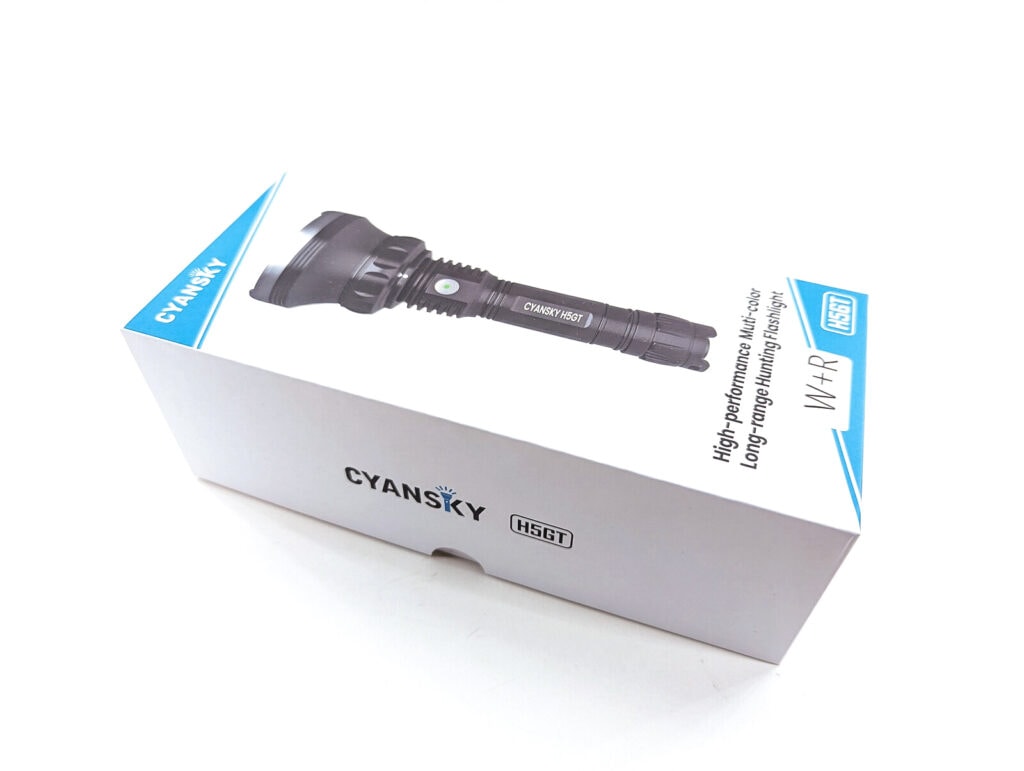
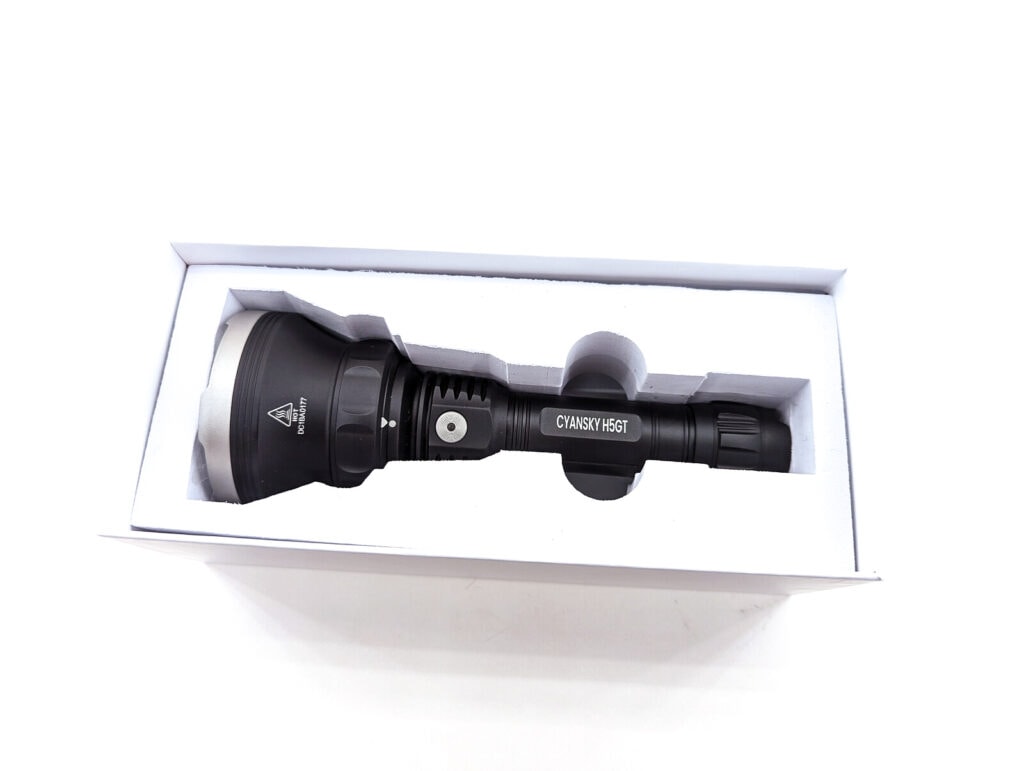
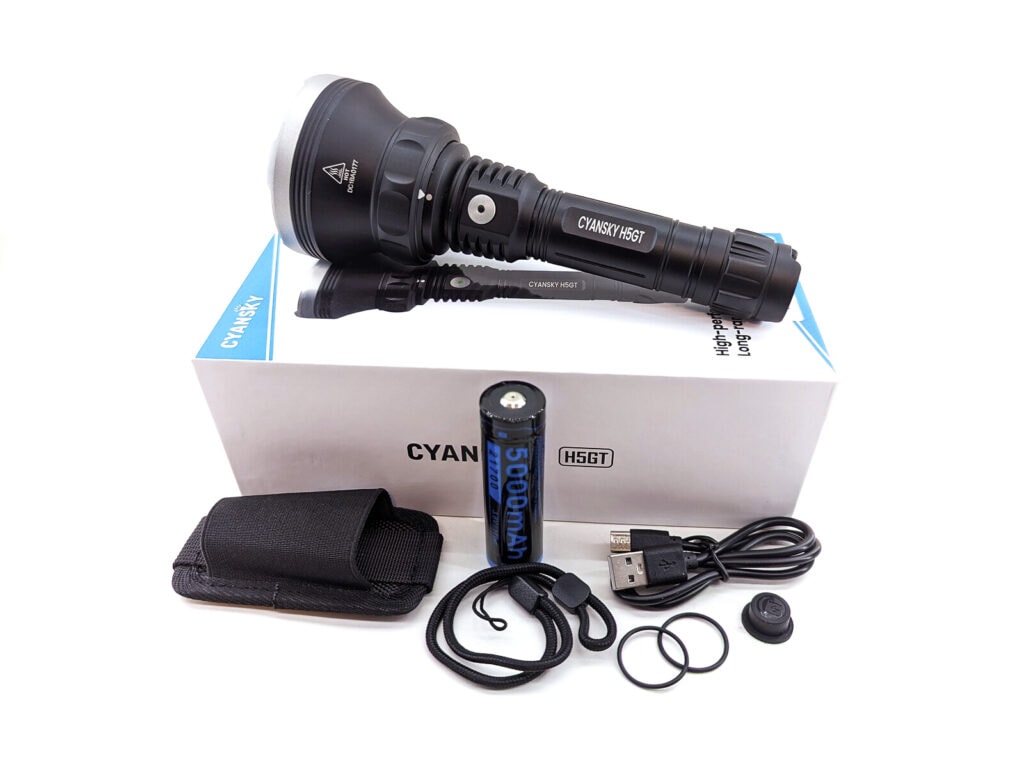
Flashlight in use
The Cyansky H5GT, being a flashlight geared towards hunting, has a flared head to accommodate a largish reflector to create a long-range beam. The trumpet-shaped head tapers down into a slender body, at least as far as 21700-based lights go. The H5GT employs a dual-switch setup. There’s the forward-clicky tail switch solely for on-off duties (including momentary), accompanied by an e-switch at the base of the head for mode-switching functions. The tail is what I consider a saddle-style, having cutouts that help with activation if you have gloves on. The tail switch button sits just proud of the aluminum, which rules out tailstanding (which would be awkward anyhow, with the flashlight being top-heavy).
The included lanyard is pretty standard stuff, not much to talk about there. The holster is a bit unique and is very minimalistic in nature. It’s essentially an oversized belt loop with a 6cm elastic strap for holding the flashlight. This makes the H5GT easy to access and stow, while providing very little bulk on your hip while you’re not using the holster. Though it doesn’t provide any protection for the flashlight (from scrapes and such) as some holsters do.
It should be pretty clear that the main intention for the Cyansky H5GT is as a hunting flashlight. It says so right on the front of the box. The long-range and multi-emitter aspects of the flashlight are helpful for night hunting for predators or feral pigs. And pairing the H5GT with the gun mount and remote switch (option accessories) complete the package. Of course you can use this Cyansky for more than just hunting, it would be right at home in many outdoor mid-to-long-range excursions. I may use it this fall to sneak into and out of the woods under the cover of dark, employing the red LED to minimize wildlife disturbances.
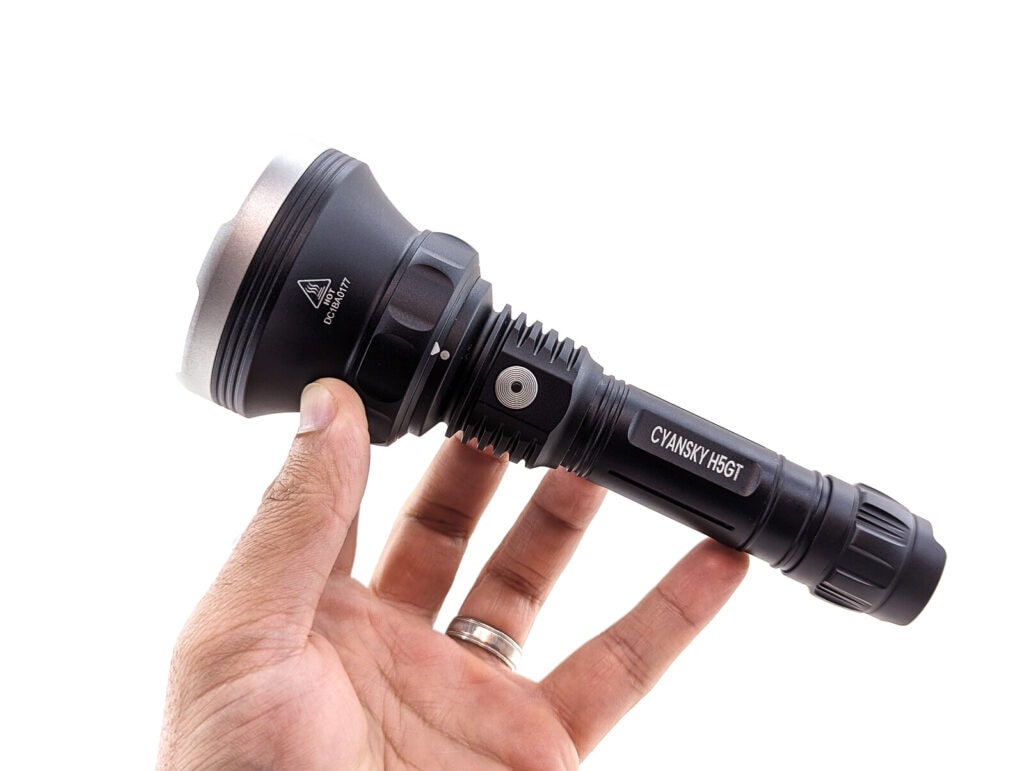
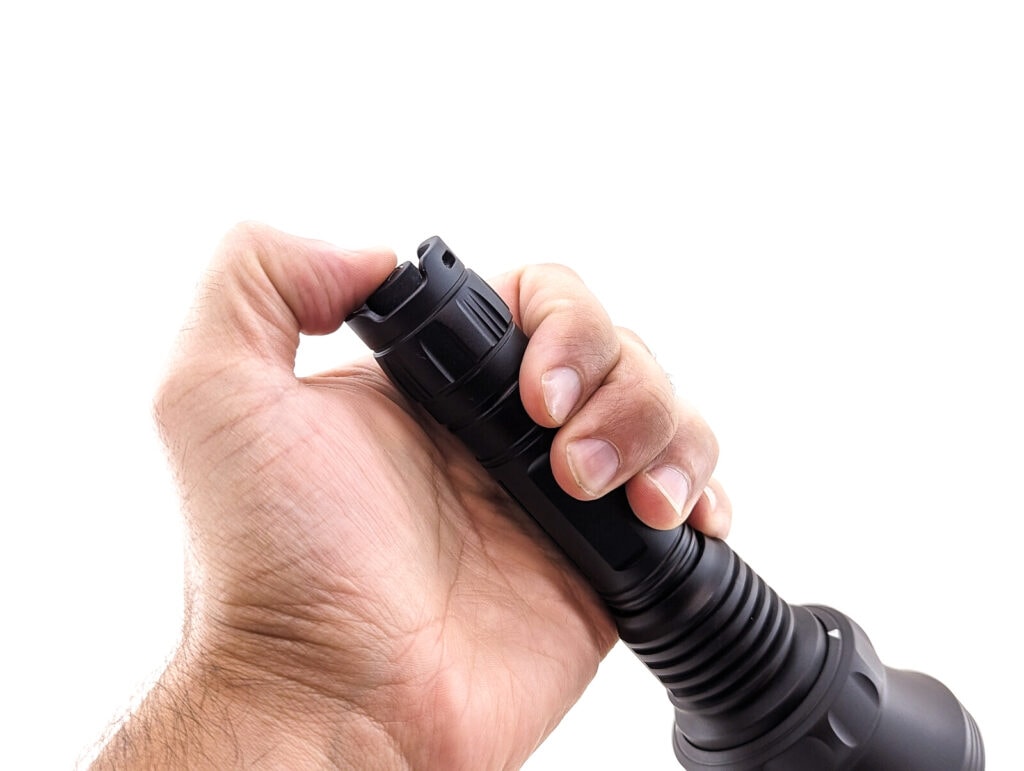

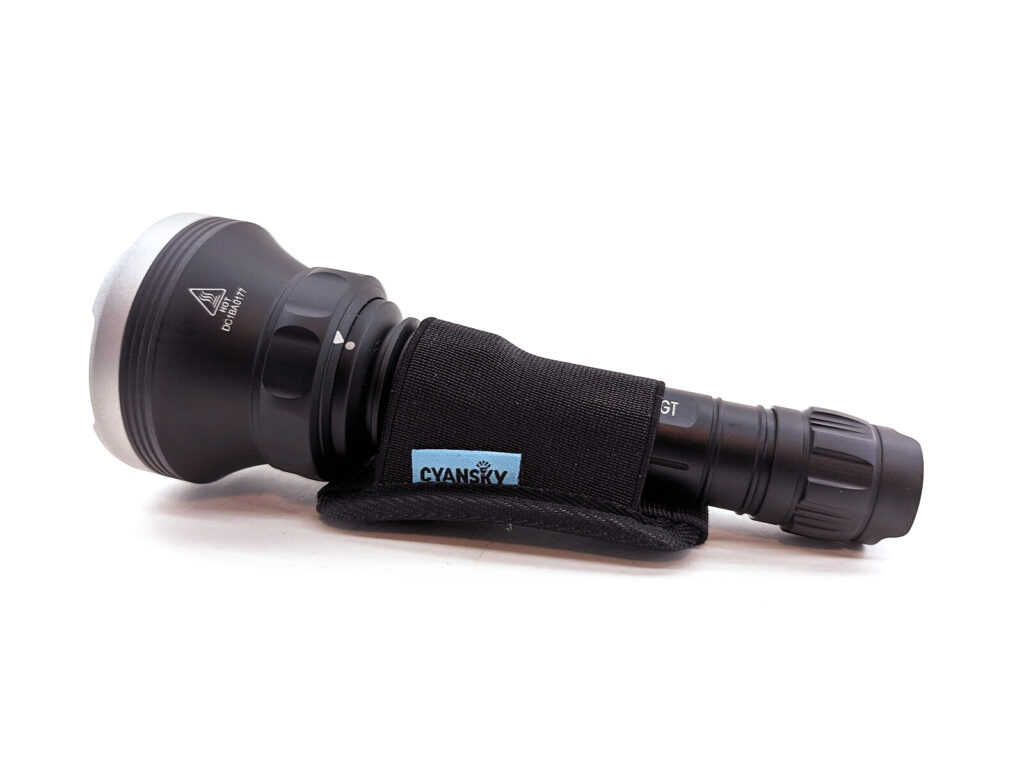
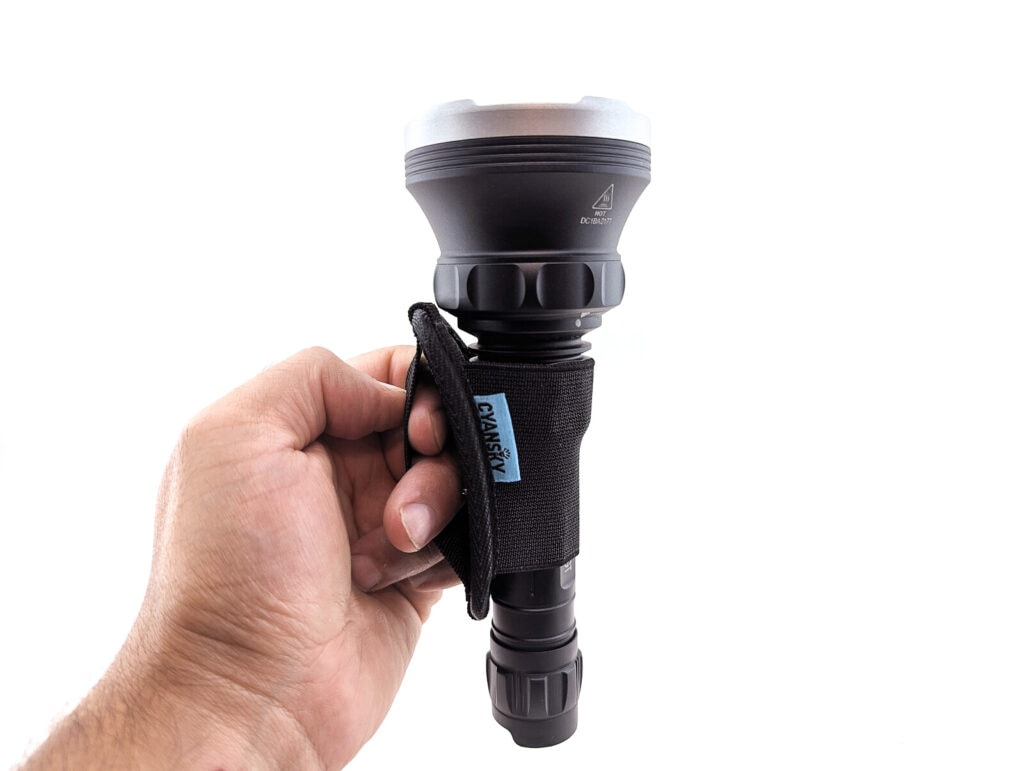
Build Quality and Warranty
The Cyansky H5GT, like most flashlights we see, is constructed from A6061-T6 aluminum. And while a lot of companies claim to use HA III hard-anodizing, I believe Cyansky’s claim of using it. The anodizing has a smooth, matte finish and is very clean and even – it looks and feels great in the hand.
The machining is very smooth. The tailcap threads are square-cut and smooth and came with a light application of lube. The rotating ring for switching LEDs is smooth but firm, and has positive feedback when you get to each end of the rotation, which is indicated by two triangular markings 180° apart.
Warranty:
- 15 days free replacement: Cyansky Light will offer a new replacement within 15 days of purchase for any manufacturing defects if the problem occurs in normal use. In case the model has been discontinued, the customer will receive a similar or improved model in time.
- 60 Months free repairs: Cyansky Light will offer free repair within 60 months (5 years) for lights from the date of purchase if problem happens with normal use.
- Limited lifetime warranty: For lights past the free repair warranty period, we provide lifetime repairs but will charge for parts. The distributor or dealer will notify customers of the cost of the part in advance.
- Batteries are covered under warranty for 12 months (1 year)

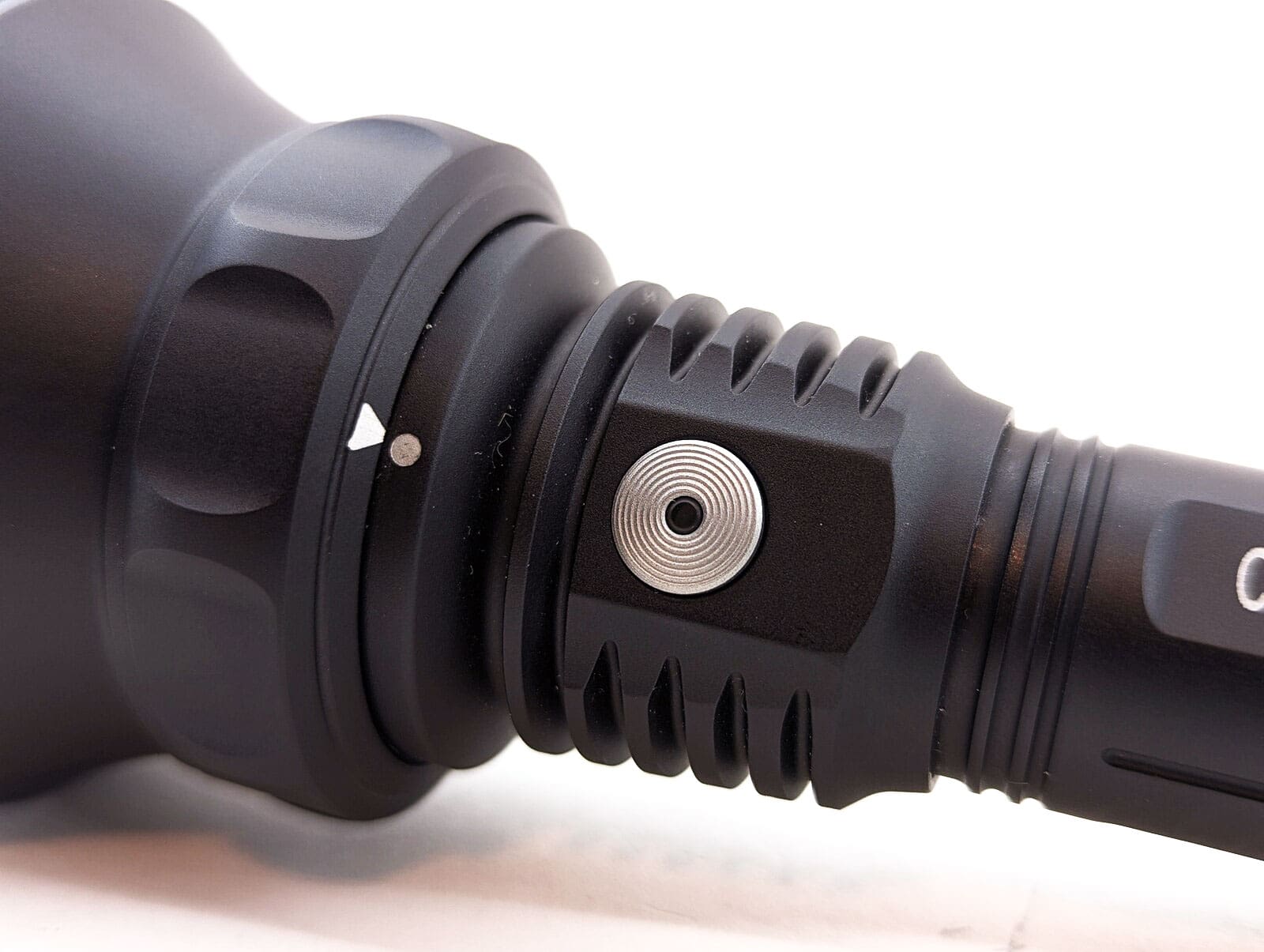
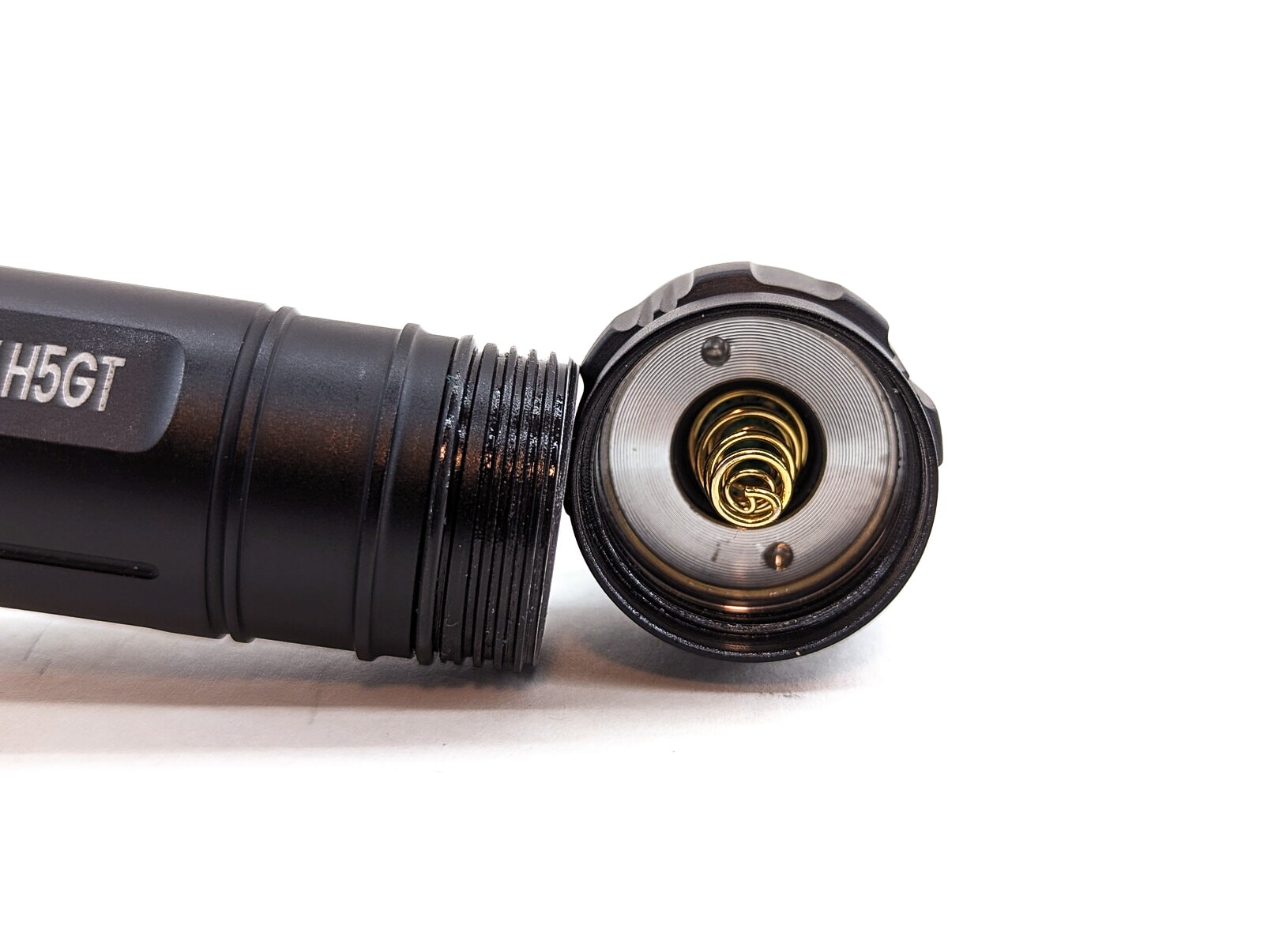
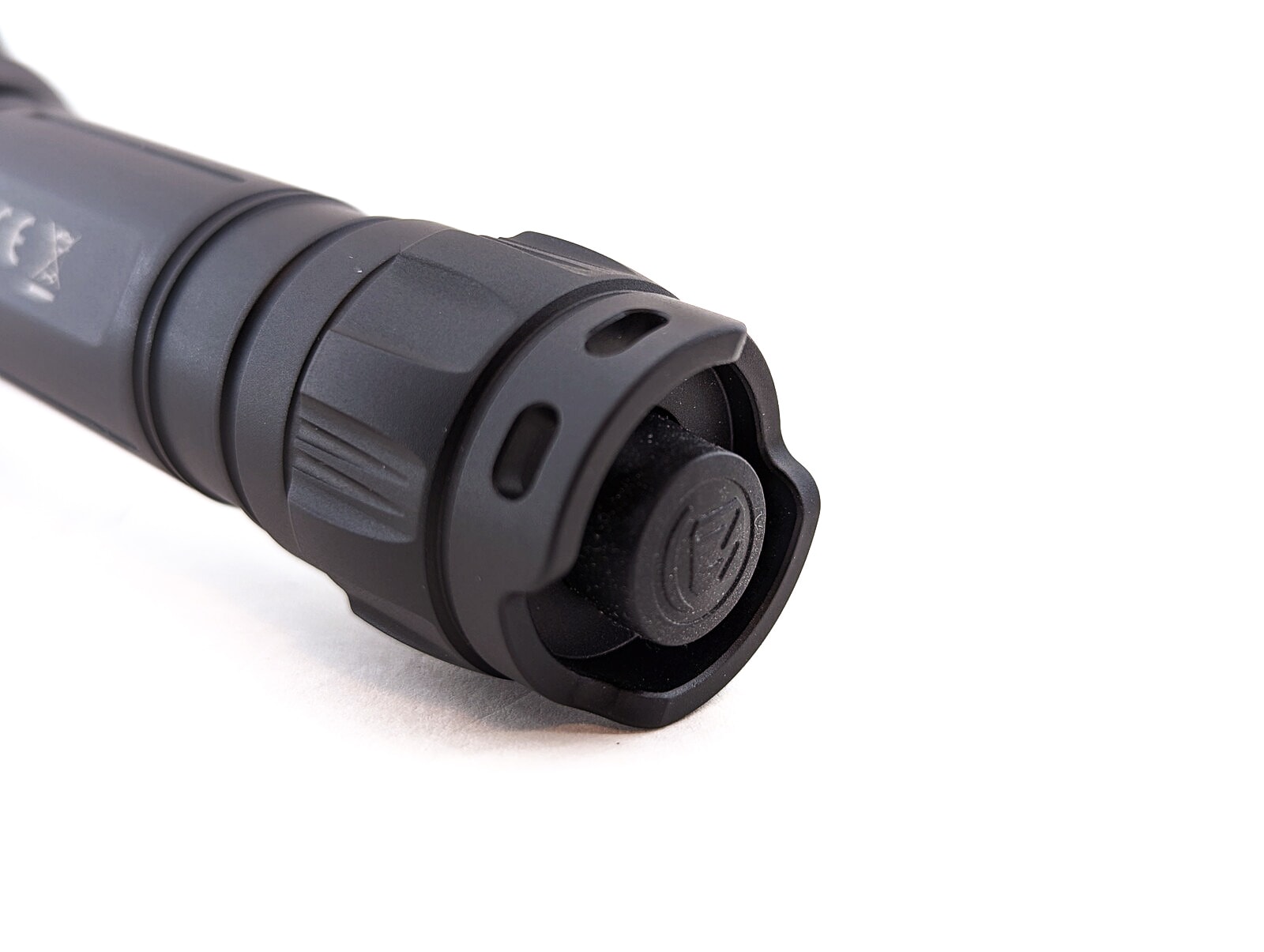
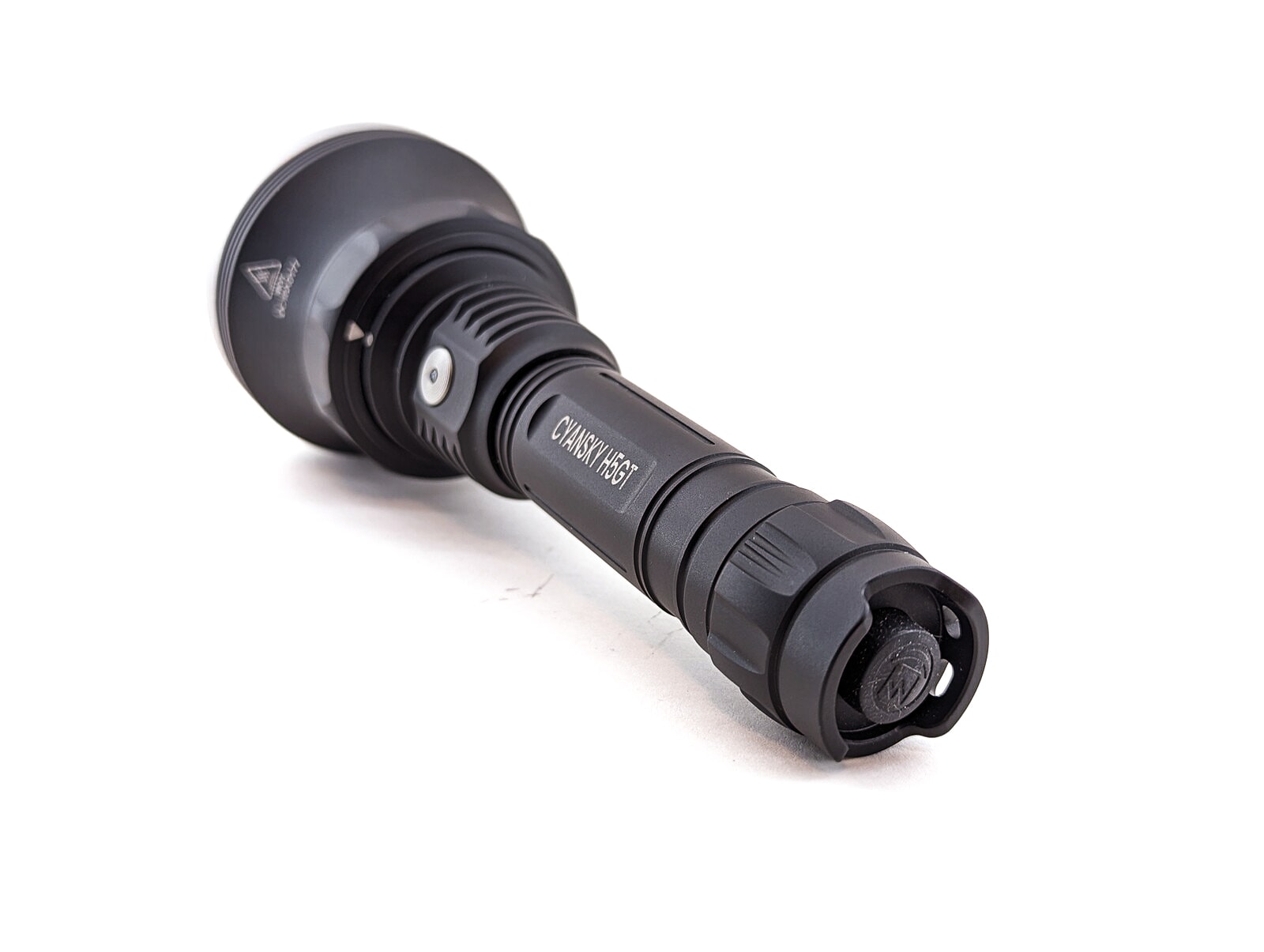
LED, Lens, Bezel, Beam, and Reflector
The business end of the Cyansky H5GT has what appears to be a stainless steel bezel with a matte finish, light crenulations, and smoothed edges. Unlike some bezels, this one won’t be tearing up fabric (pockets, backpack, etc). Under the bezel is a tempered glass lens with a double-side anti-reflective coating. The vacuum-plated aluminum reflector is part of the main attraction with the H5GT. It’s a patented “world’s first design: rotatable large reflection cup with a single outlet.”
Most flashlights with multiple color outputs employ one of three sub-par methods to achieve that: either (a) swappable external filters, (b) swappable LED modules, or (c) multi-reflector (or TIR) designs. I’m not a huge fan of the first two options, because when I’m out in the field, I really don’t want to be carry extra components and taking the time to swap them out. And with LED modules, you’re opening up the flashlight and exposing the internals to the elements. No good. And while multi-reflector or multi-TIR designs eliminate that complaint, they tend to not be very good at longer ranges because they have small reflectors (or TIRs) so that they can accommodate more of them. For these reasons, I’ve never been very enthused about the color-swapping options for hunting flashlights.
So when I saw what Cyansky created for the H5GT, I was thoroughly impressed. This is a color-swapping system that I would actually make use of! You can switch between white and red (or green, or blue, depending on the model you buy) without need to carry any accessories and without needing to open the flashlight – it’s all done with a quick twist of the ring at the head of the flashlight. Twisting the ring rotates the reflector and centers one of two LEDs in the middle.
Granted, the concept of quick-changing with a ring isn’t completely new for Cyansky. They did the same thing with the original H5, but that system relied on swapping out internal color filters. That’s not bad, but color filters imply some light loss. Swapping LEDs negates that downside.
So what LED options do you have? Well, all 3 models come with the domeless Luminus SFT-40-W for the white LED. For the secondary LED, you have your choice of Red (Luminus SFT-20-RA), Green (Luminus SFT-20-CG-F35-MPF), or Blue (Luminus SFT-20-B-F35). My sample came with the Red option, which I do like for navigating around the woods after sundown.
Measurements from the Opple Light Master at 5m (white, turbo):
- CCT: 7212K
- CRI: 70.1 Ra
- DUV: +0.0001
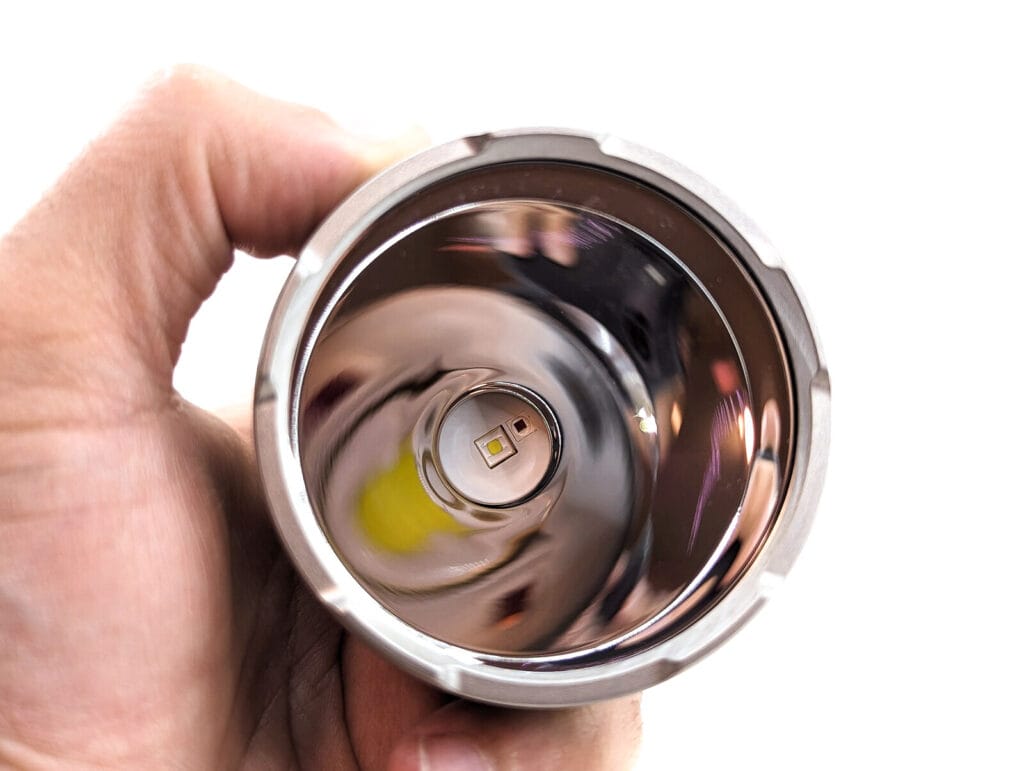
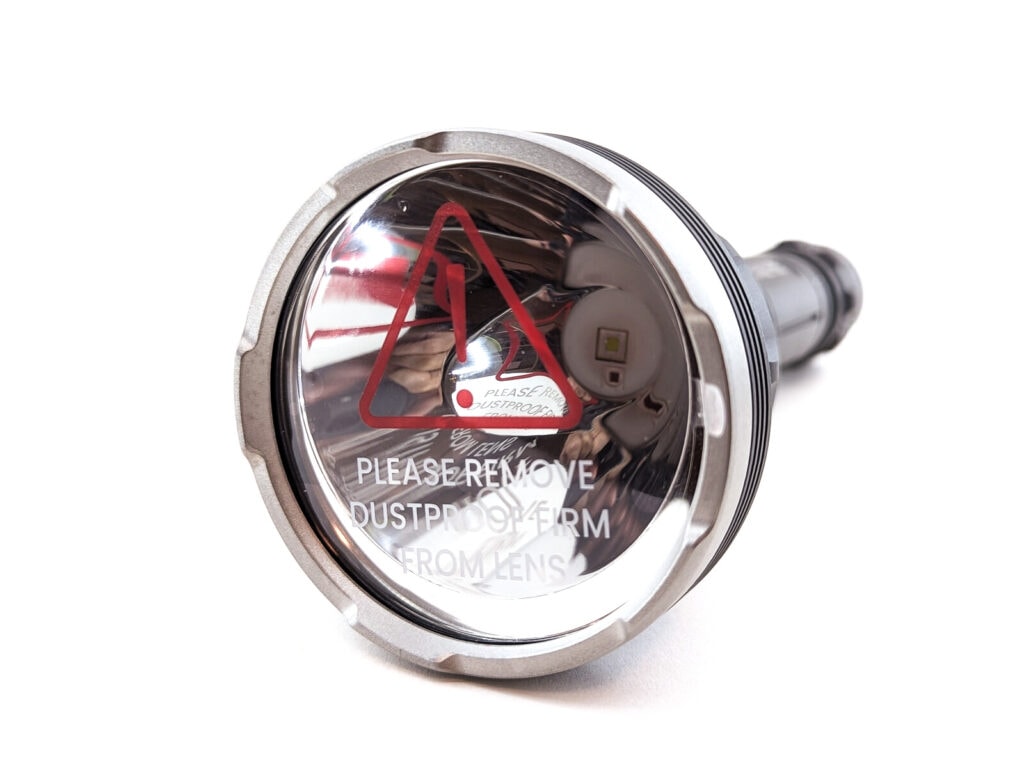
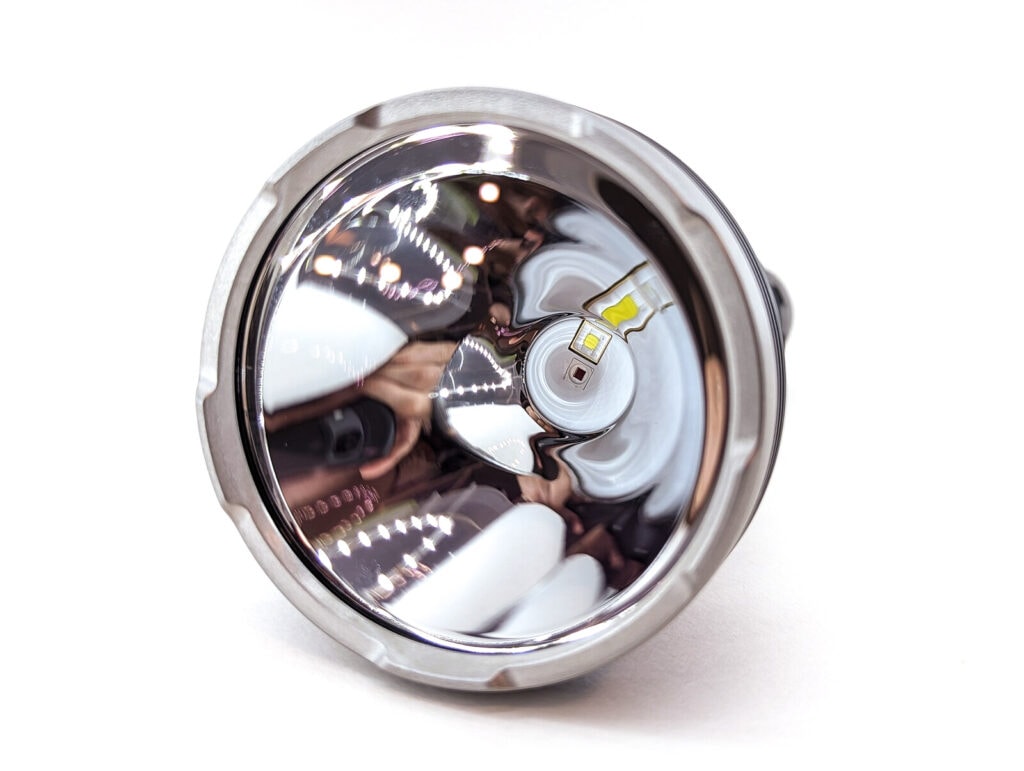
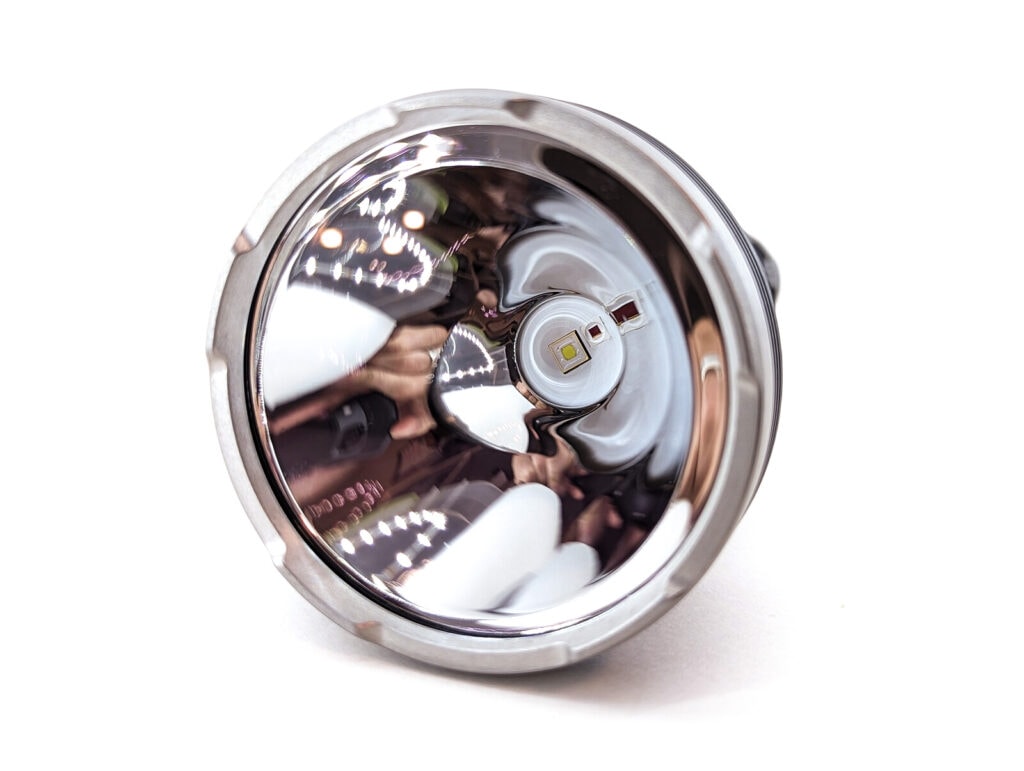
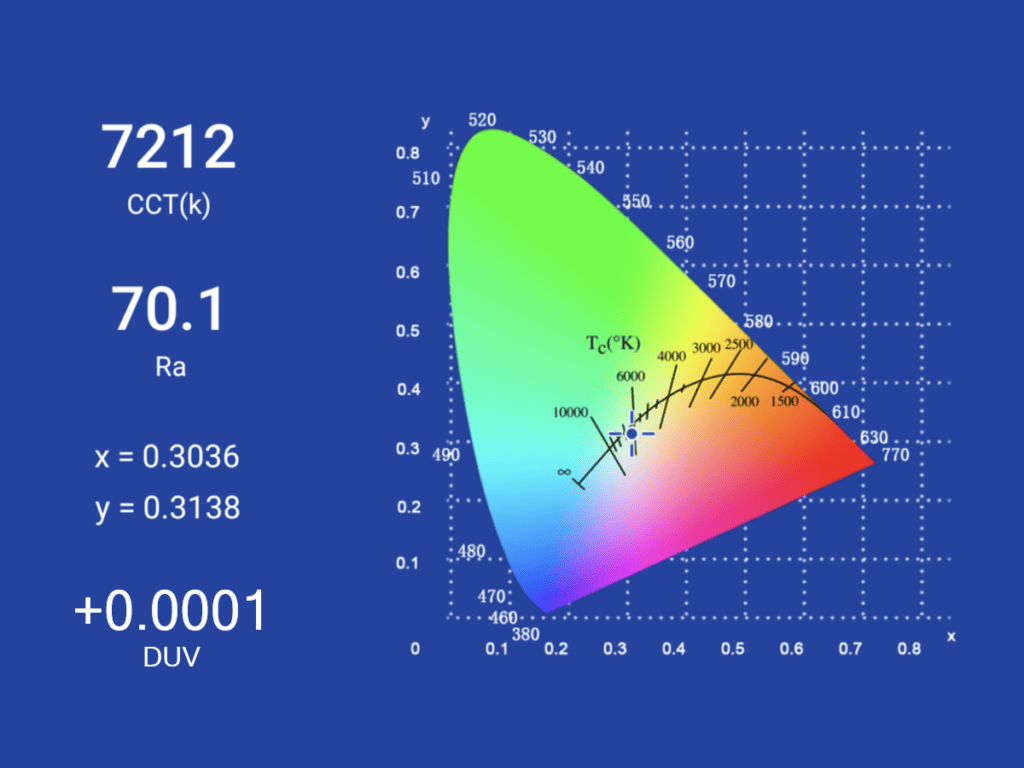
Dimensions and its competition
| Cyansky H5GT | Millimeters | Inches |
|---|---|---|
| Length | 182 mm | 7.2 in |
| Head diameter | 68 mm | 2.7 in |
| Body diameter | 26 mm | 1.0 in |
Dimensions are rounded to the nearest millimeter, and to the nearest tenth of an Inch.
Weight:
| Cyansky H5GT | Weight in grams | Weight in oz |
|---|---|---|
| Without battery: | 297 g | 10.5 oz |
| With battery | 369 g | 13.0 oz |
Flashlight size comparison with its competition:
Group 1: Mateminco MT35 Mini, Cyansky H5GT
Group 2: Speras TH12, Cyansky H5GT
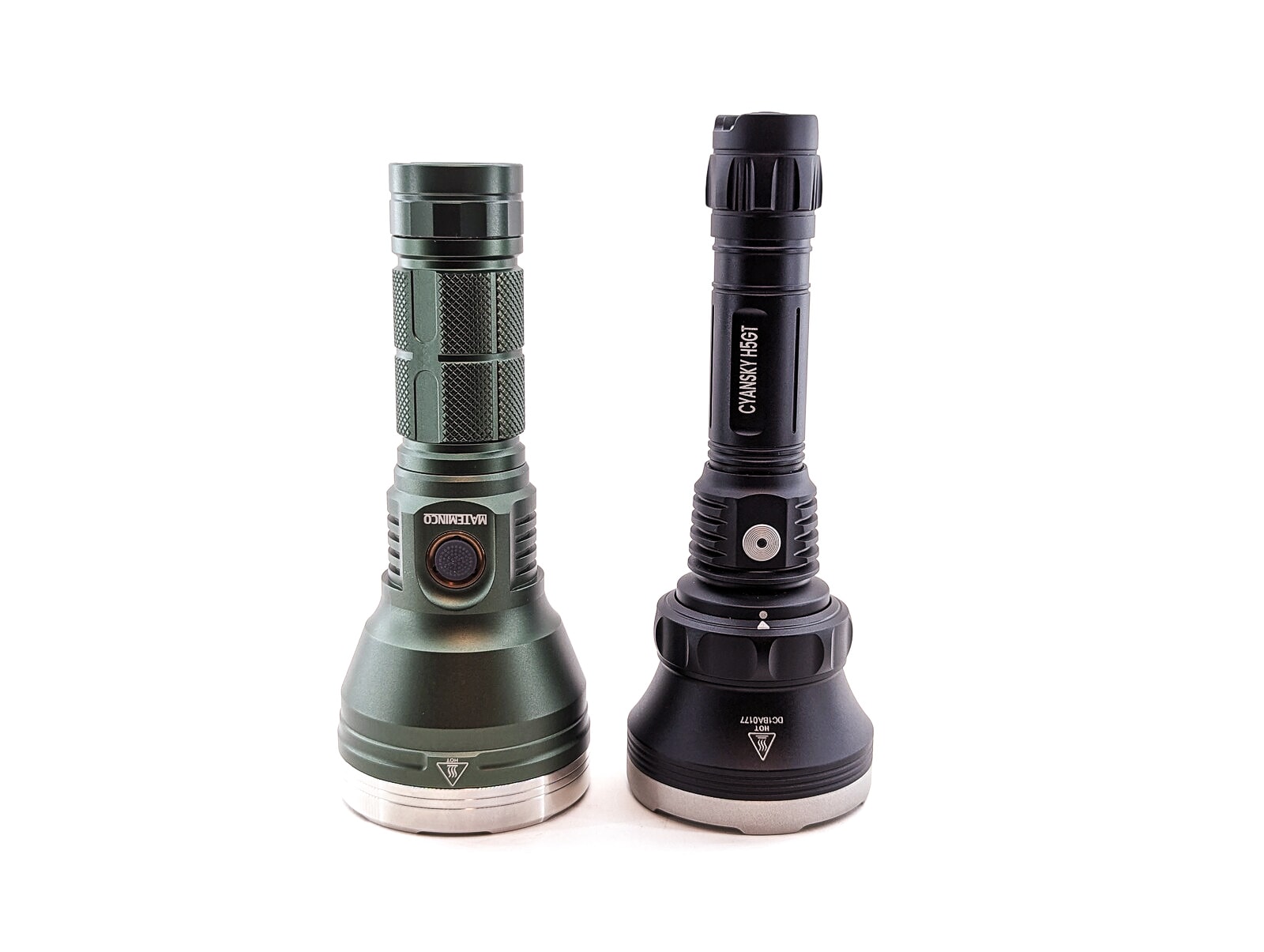
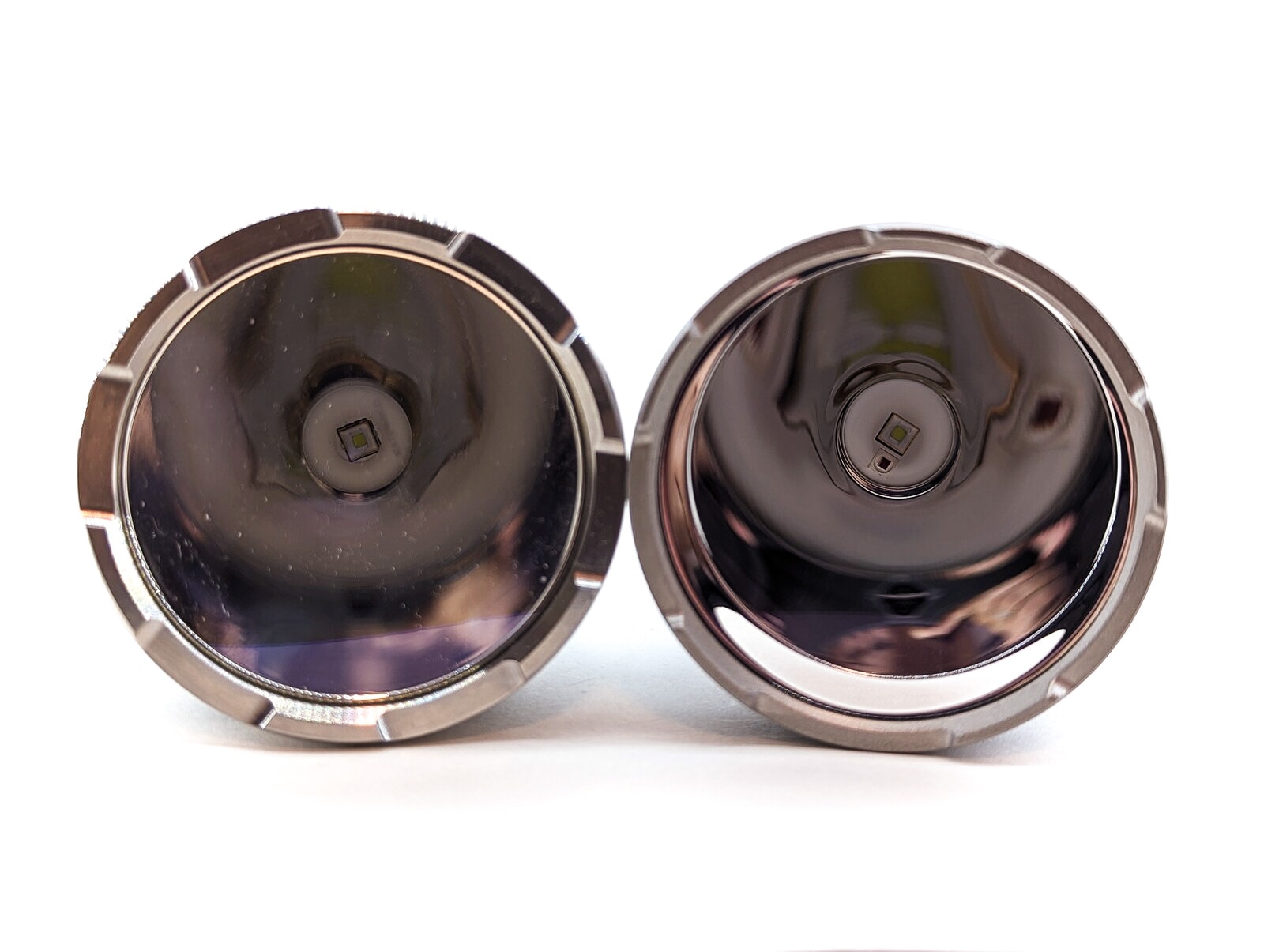
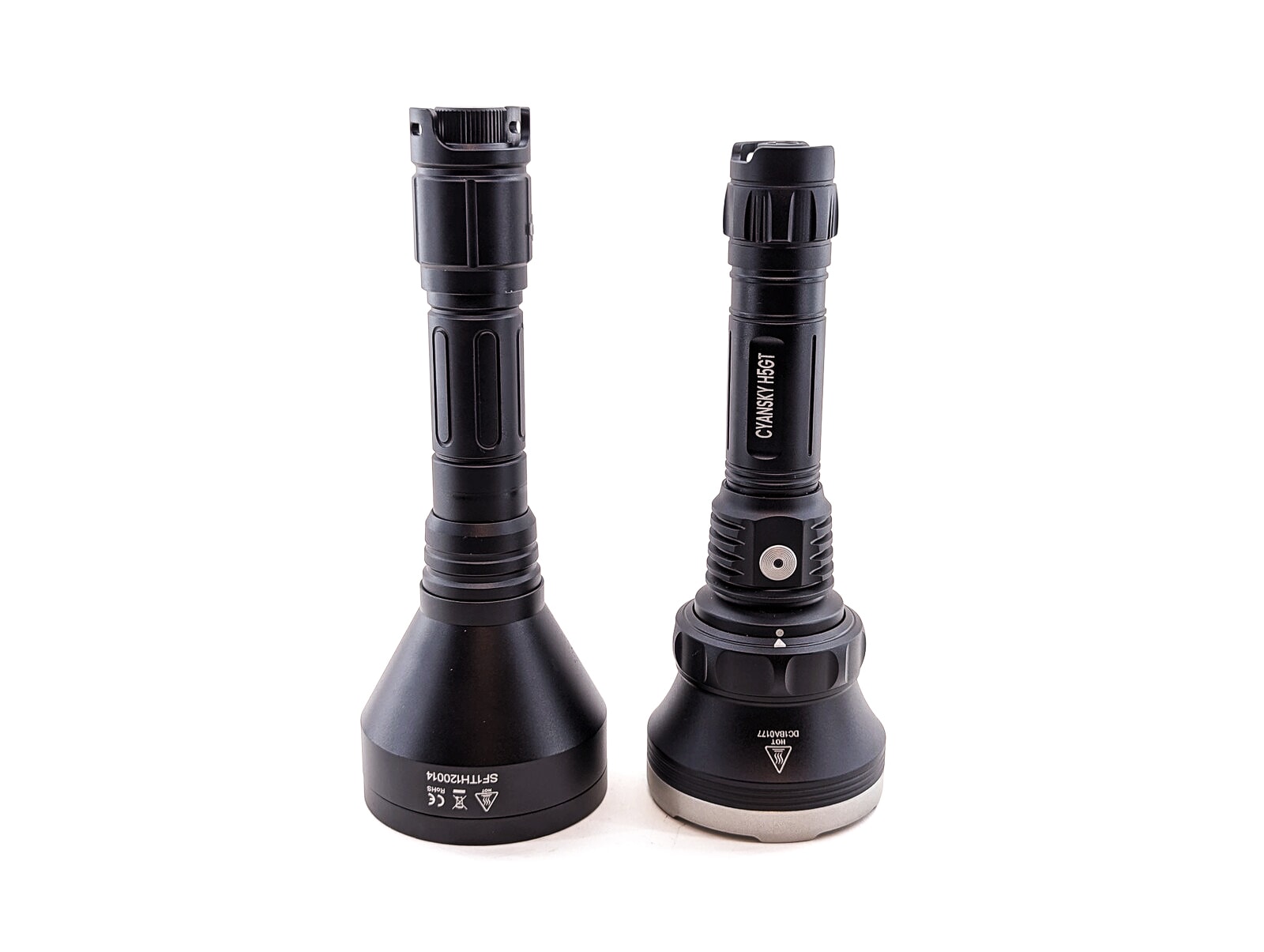

Cyansky H5GT UI: User Interface and Driver
The UI of the Cyansky H5GT is about as easy as it gets, thanks to the dual-switch UI. The rear forward-clicky switch provides on-off-momentary functions, while the front e-switch just rotates through modes.
When the white LED is enabled, there are four brightness levels. When a color LED is enabled, there are three levels (no Turbo). There doesn’t appear to be any blinky modes.
Available modes:
- Low, Medium, High, Turbo (for white only)
Available blinky modes:
- N/A
From OFF:
- Tail switch, press and hold: momentary on
- Tail switch, single click: turn on
From ON:
- Tail switch, single click: turn off
- E-switch, single click: change modes
Mode memory:
- Yes, all modes can be memorized
Shortcuts:
- None
Low voltage warning/protection:
- The main LED blinks occasionally when the battery is running low
- There is also an indicator LED in the front switch to show battery status:
- Green solid: >75%
- Green flash: 50-75%
- Red solid: 25-50%
- Red flash: <25%
Strobe/blinkies
- None
Lock-out mode:
- There’s no lockout mode but the tail cap can be unscrewed slightly to stop the light turning on
PWM
- My photodiode + DMM seemed to pick up a little bit of PWM, but I don’t think it was fully PWM as we usually think about it. I think it may have been small, rapid adjustments in output from a switch-mode current (buck?) driver.
Additional/summary info on the UI:
- The dual-switch UI is very simple
Cyansky H5GT Charging and batteries
The Cyansky uses 21700 batteries, and comes with one: model Cyansky BL2150U. It’s a protected 5000 mAh cell with built-in USB-C charging. At 76.4mm, it’s a touch long. But thanks to having a spring in both the head and tail, the H5GT is very accommodating with batteries. I tried a flat-top Samsung 50G and it worked just fine, even when intentionally bumping it firmly.
Cyansky says that it should take 3.5 hours to charge the BL2150U, and I can confirm that. The charging rate was 7.0W and it took 3h 37min to complete the cycle. The battery has a little indicator LED that shines through a pinhole in the positive terminal. It shines brightly red when charging, and switches to green when complete.

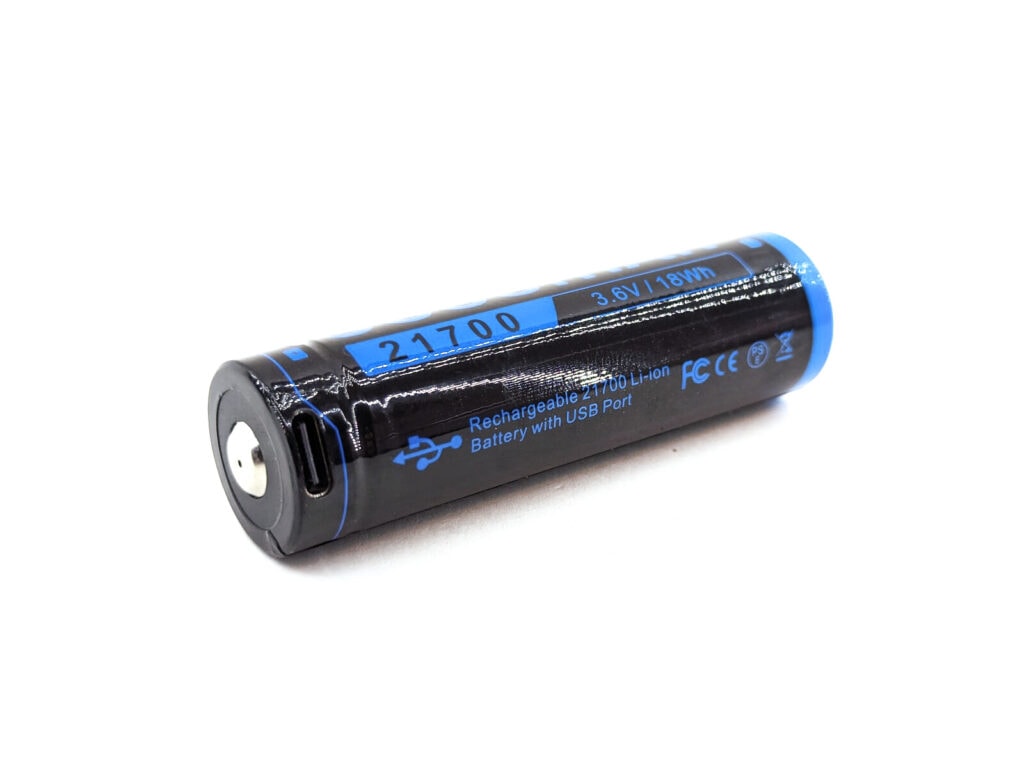
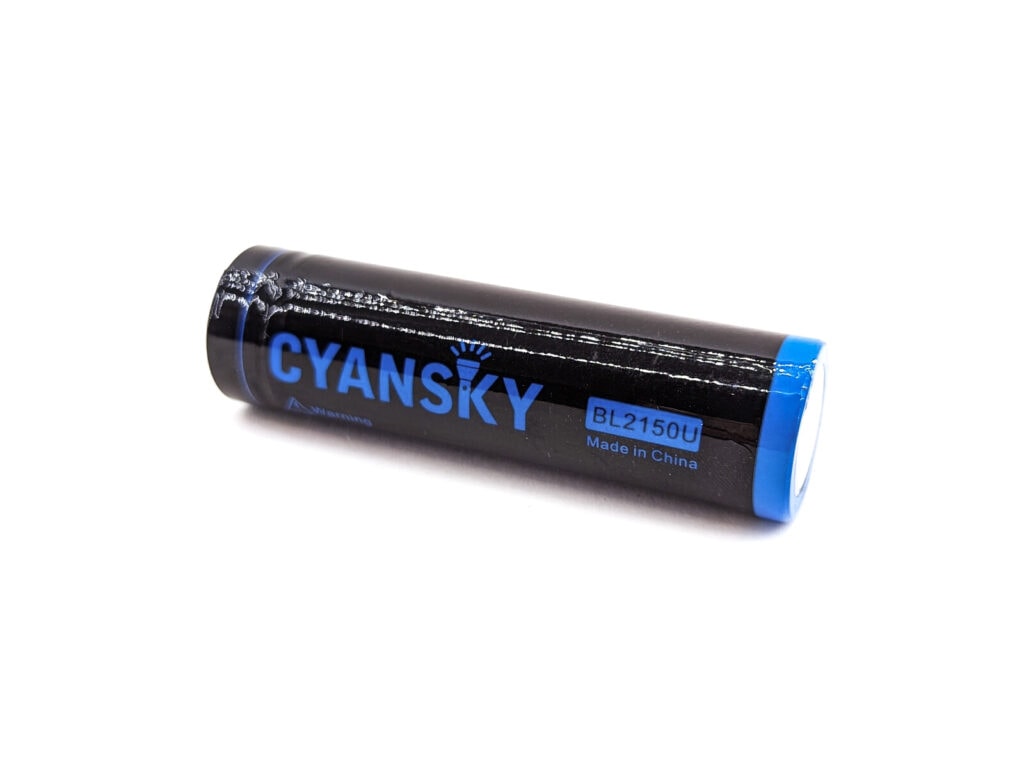
Performance test
Lumen measurements
How Lumens are Measured: Understanding ANSI FL1 Standards How Lumens are Measured: Understanding ANSI FL1 Standards: The ANSI FL1 standards specify that output in lumens should be measured 30 seconds after turning on, as this is the standardized time for measuring brightness according to the industry standard. This is why we focus on this part in our measurements. The ANSI FL1 standards require an ambient temperature of 22 ± 3°C. We record the ambient the ambient temperature to identify potential reasons for any observed discrepancies.Lux was measured by a UNI-T UT383 BT at 10 meters. Lumens were measured in a homemade lumen tube using a VEML7700 sensor, calibrated with a calibration light provided by 1Lumen. The provided Cyansky battery was used for testing.
| Mode | Amps at start | Specs | turn on | 30 sec | 10 minutes |
|---|---|---|---|---|---|
| White, Low | 66 mA | 30 | 39 lm | 39 lm | |
| White, Med | 265 mA | 150 | 125 lm | 126 lm | 126 lm |
| White, High | 1.6 A | 800 | 806 lm | 804 lm | 795 lm |
| White, Turbo | 7.0 A | 2000 | 2224 lm | 2066 lm | 919 lm |
| White, Turbo at 3.6V | 4.7 A | 1772 lm | 1668 lm | – | |
| Red, Low | 210 mA | 30 | 25 lm | 25 | – |
| Red, Med | 0.9 A | 150 | 101 lm | 99 lm | 96 lm |
| Red, High | 5.1 A | 400 | 362 lm | 327 lm | 187 lm |
Parasitic drain:
- N/A (the clicky switch eliminates standby drain)
I love it when a flashlight performs according to specs, and in a predictable manner. Thermal regulation did cause the output to drop after the first minute or so, which seemed a bit premature as the flashlight was only at 40°C (externally) at that point.
Cyansky H5GT Battery Life: Runtime graphs
How Runtimes are Measured: Understanding ANSI FL1 Standards About ANSI FL1 runtime standards: The runtime is measured until the light drops to 10% of its initial output (30 seconds after turning on). This does not mean that the flashlight is not usable anymore. The last column shows how long the light actually works till it shuts off. If there is a + symbol, it means that the test was stopped at that particular point, but the light was actually still running. This happens on certain occasions, with certain drivers, firmware, or batteries.| Mode | Specified runtime | Measured runtime ANSI | Time till shut off |
|---|---|---|---|
| White, Low | 68h | – | – |
| White, Med | 15h 48min | 15h 56min | 16h 51min+ |
| White, High | 3h | 2h 52min | 6h 39min+ |
| White, Turbo | 1h 24min | 2h 8min | 6h 27min+ |
| Red, Low | 20h 30min | – | – |
| Red, Med | 5h 24min | 5h 27min | 5h 27min |
| Red, High | 1h 48min | 2h 25min | 3h 32min |
Again, there are no real surprises here. These runtimes line up very closely with the numbers that Cyansky provides. The red modes had a pretty clear-cut shutoff, but the white modes seemed to poke along for hours after dropping down to a few lumens.
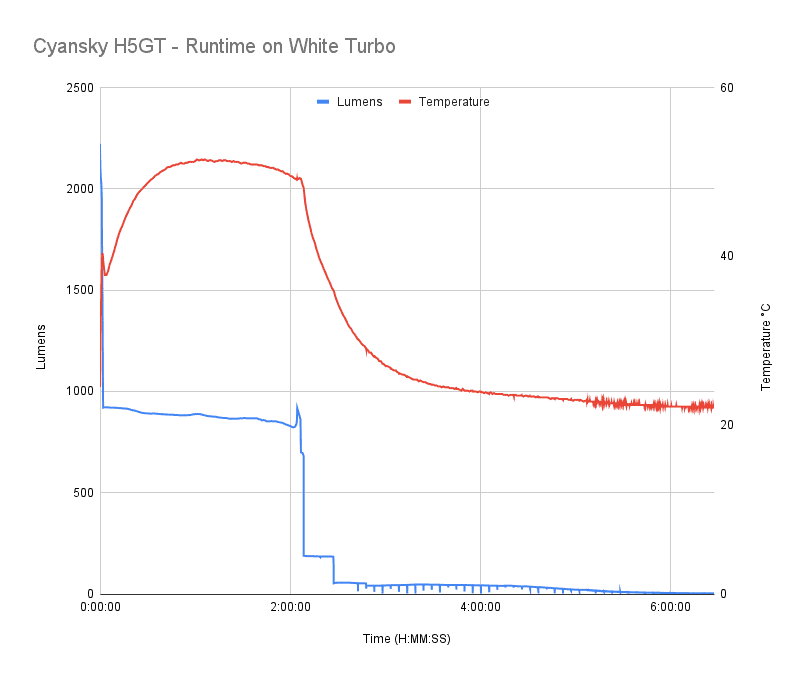
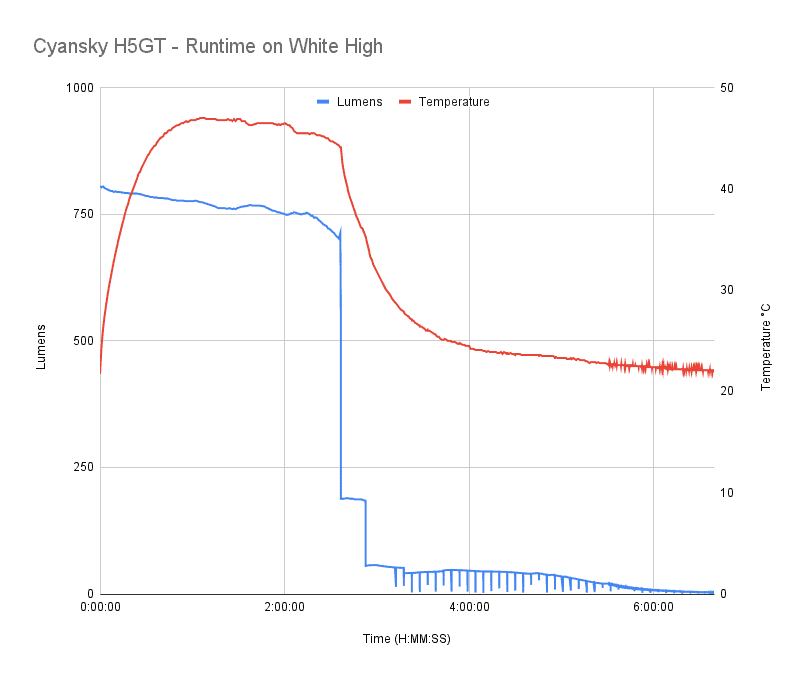
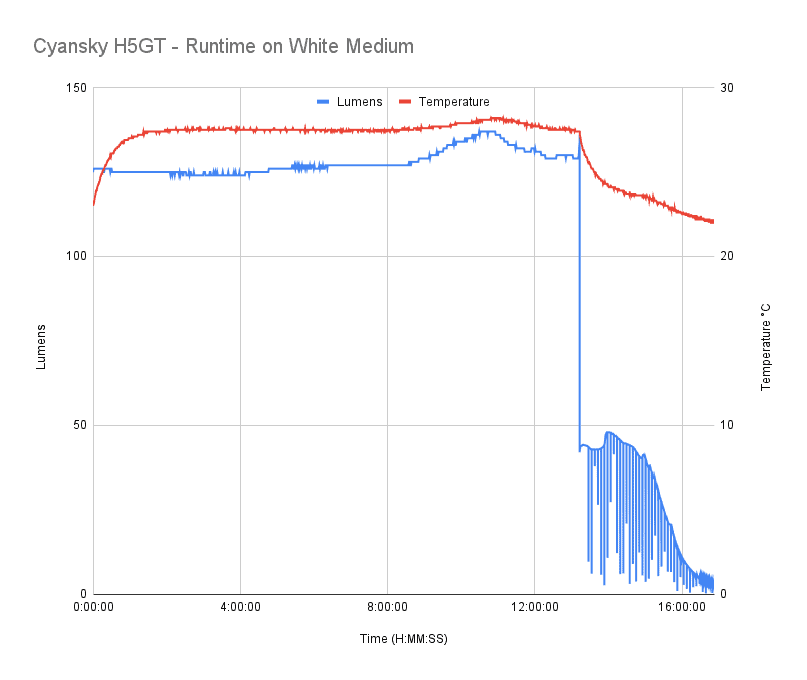
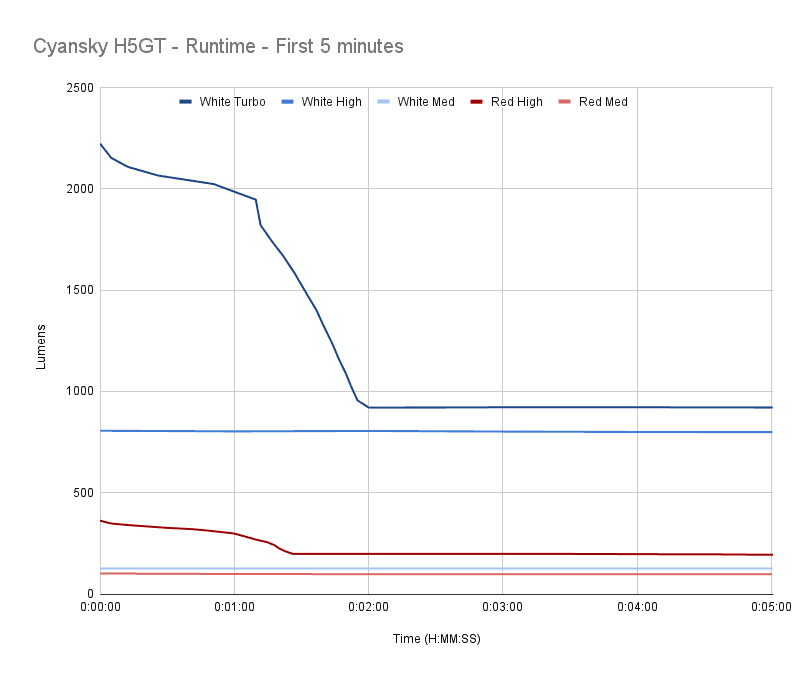
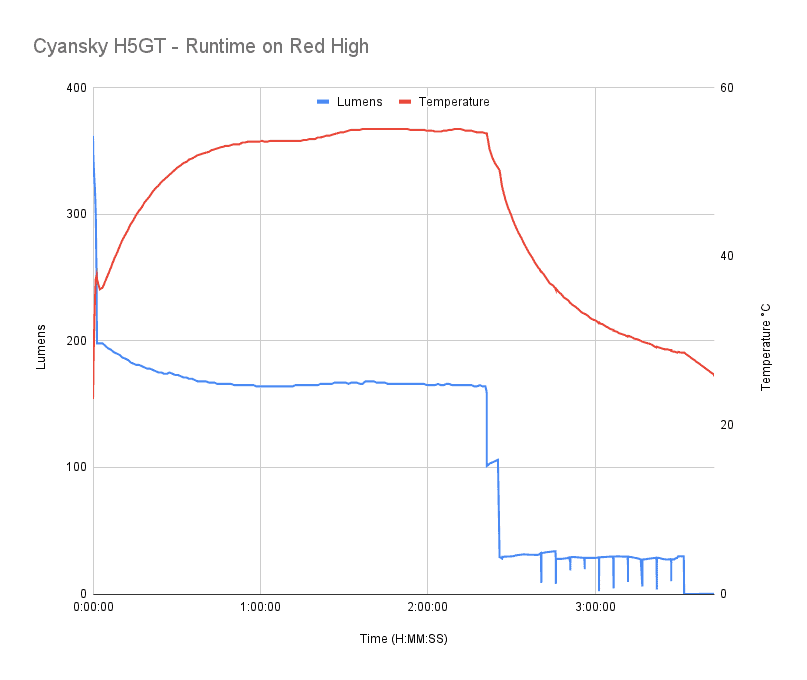
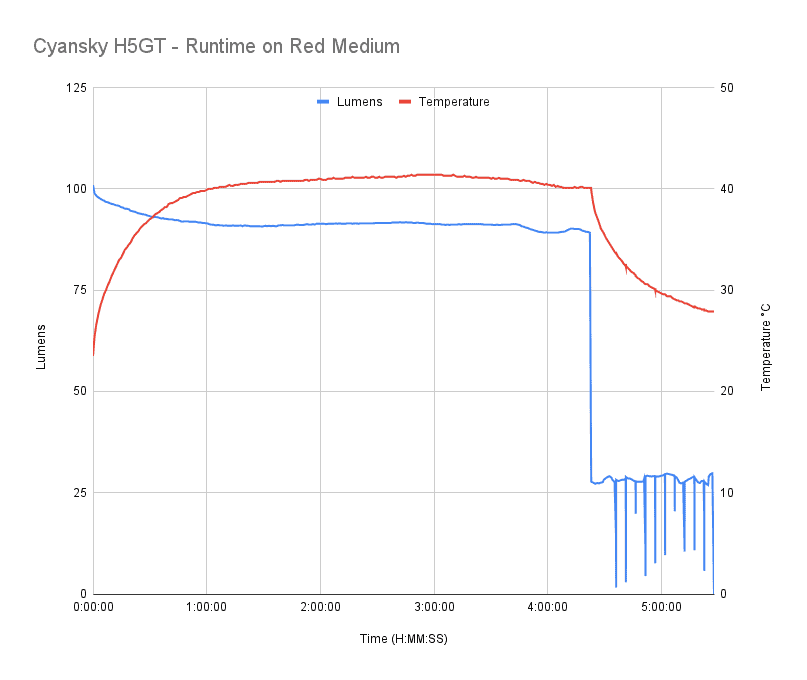
Peak beam intensity and beam distance measurements
About Peak beam intensity: Understanding ANSI FL1 Standards About peak beam intensity The calculated value of distance in meters at which the flashlight produces a light intensity of 0.25 lux. (0.25 lux is about the brightness of a full moon shining on an object). This means that the intensity has decreased so much, it becomes difficult to see darker objects, or objects that don’t reflect light. The columns ‘Meters’ and ‘Yards’ use rounded numbers.Throw was tested at 5 meters with my UNI-T UT383 BT
| Mode | Specs | Candela measured | Meters | Yards |
|---|---|---|---|---|
| White, Low | 4,556 cd | 5,700 cd | 151 m | 165 yd |
| White, Med | 22,500 cd | 26,775 cd | 327 m | 358 yd |
| White, High | 105,625 cd | 115,775 cd | 681 m | 744 yd |
| White, Turbo | 250,000 cd | 303,850 cd | 1,102 m | 1,206 yd |
| Red, Low | 11,025 cd | 11,325 cd | 213 m | 233 yd |
| Red, Med | 42,025 cd | 42,375 cd | 412 m | 450 yd |
| Red, High | 90,000 cd | 90,525 cd | 602 m | 658 yd |
Again, no real surprises here – Cyansky seems to have provided very truthful numbers. I even measured a bit higher intensity for the white turbo mode than expected, which is a plus for a long-range flashlight
Beamshots
Camera settings and distance:
Beam shots of the building are taken at 50 m (55 yd) using a Pixel 7 set to ISO 800 with 1/20 second exposure time
Beamshots of the following flashlights compared:
- Cyansky H5GT, white
- Cyansky H5GT, red
- Mateminco MT35 Mini with SFT40
- Speras TH12
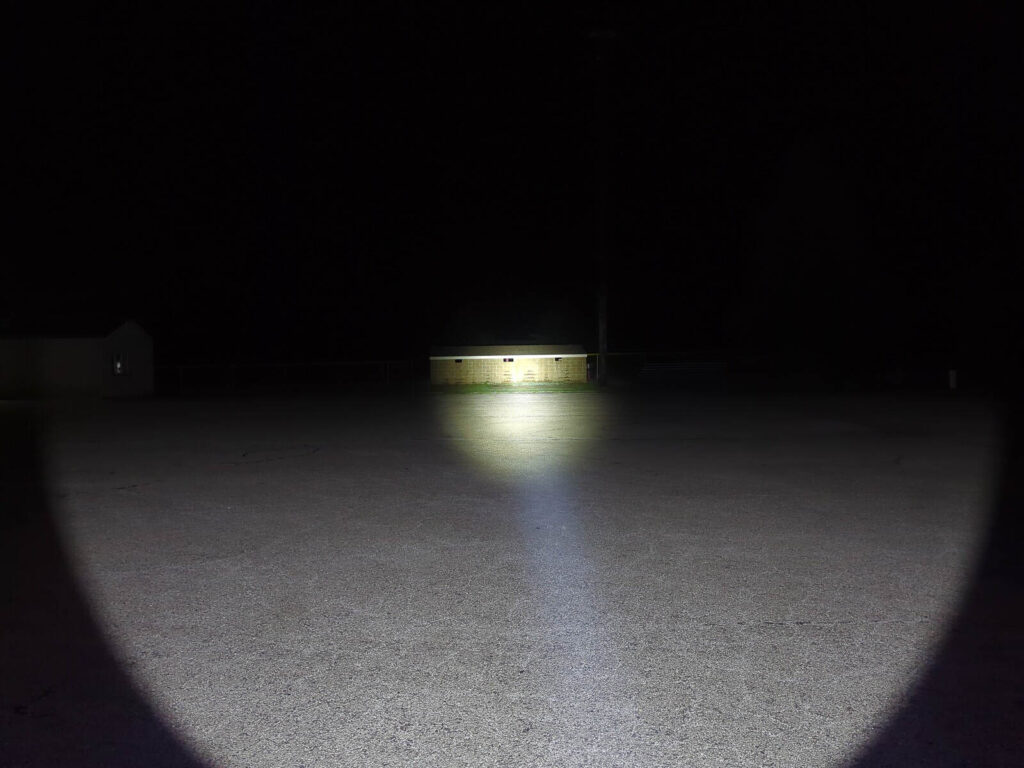
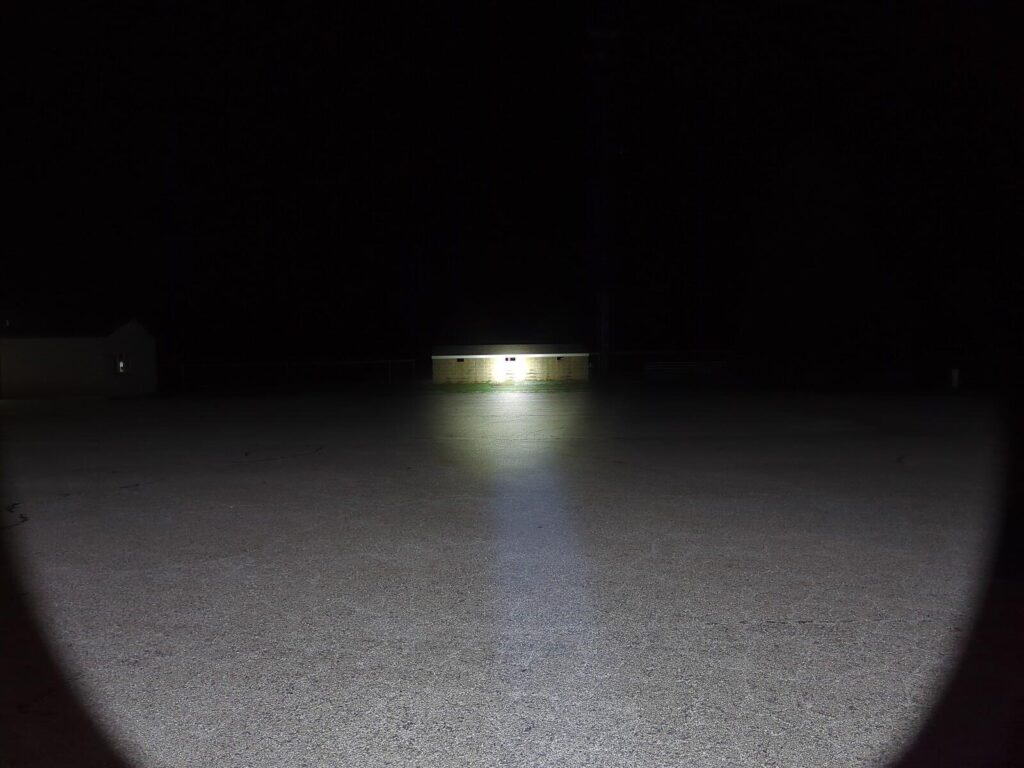
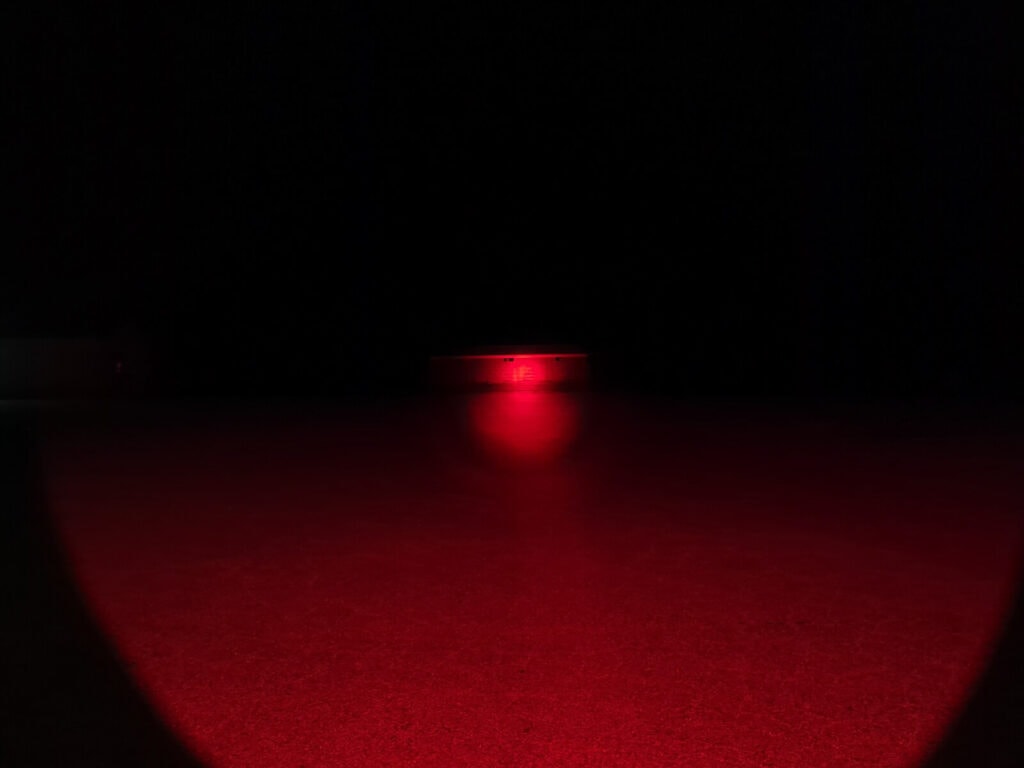
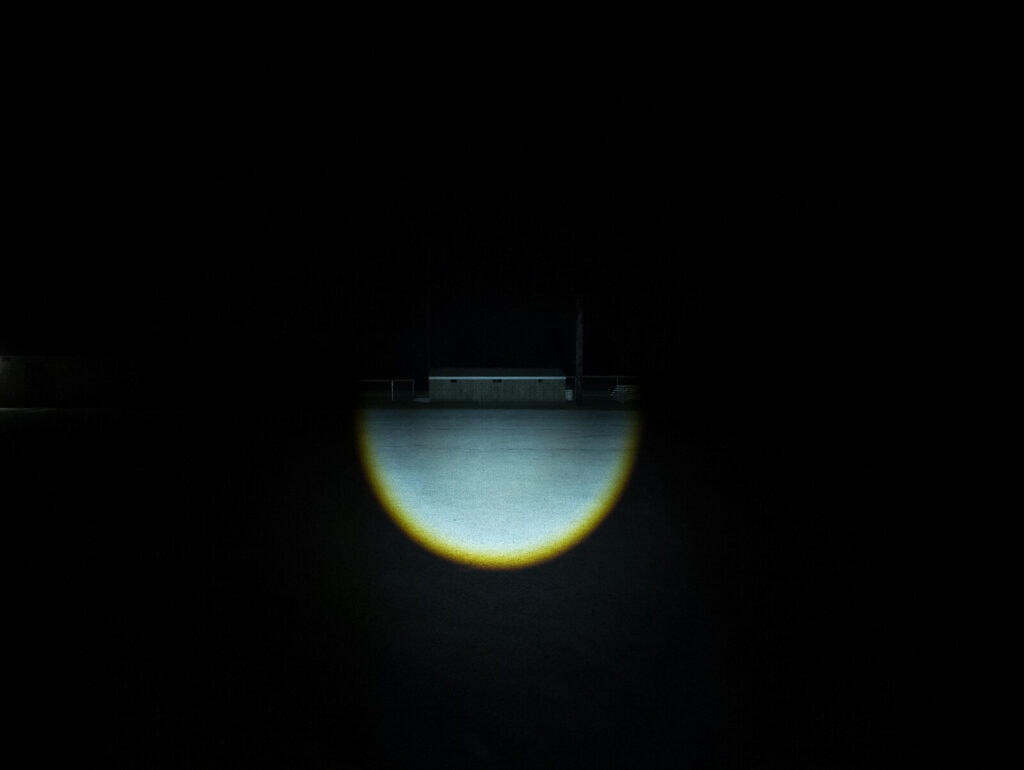
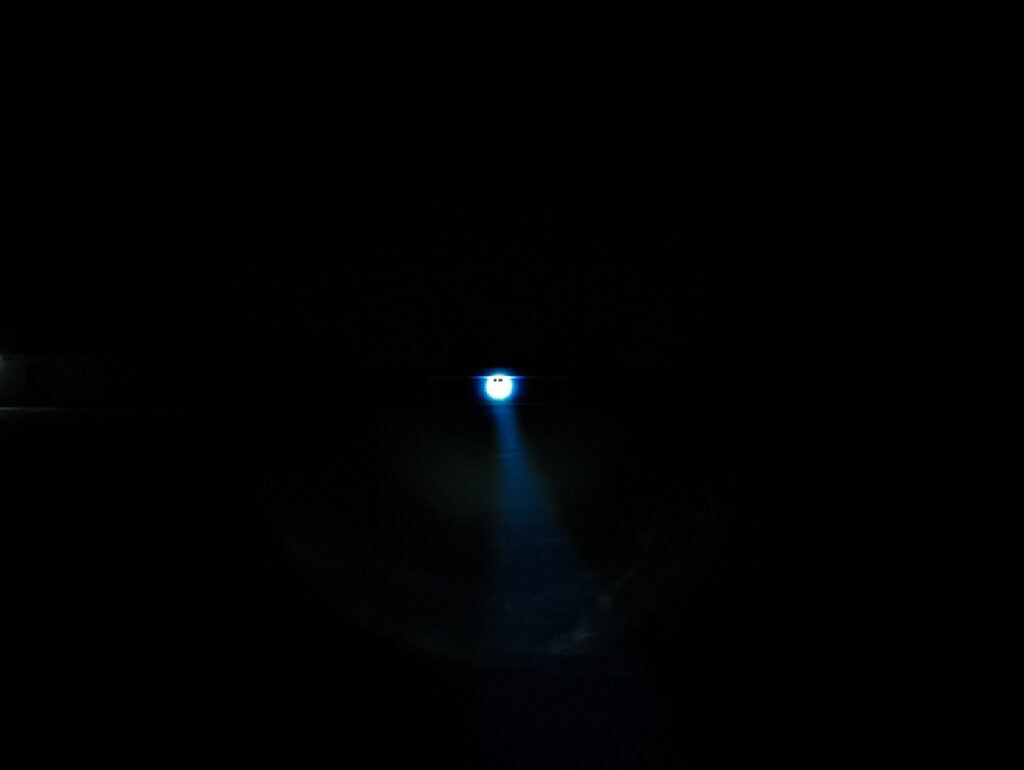
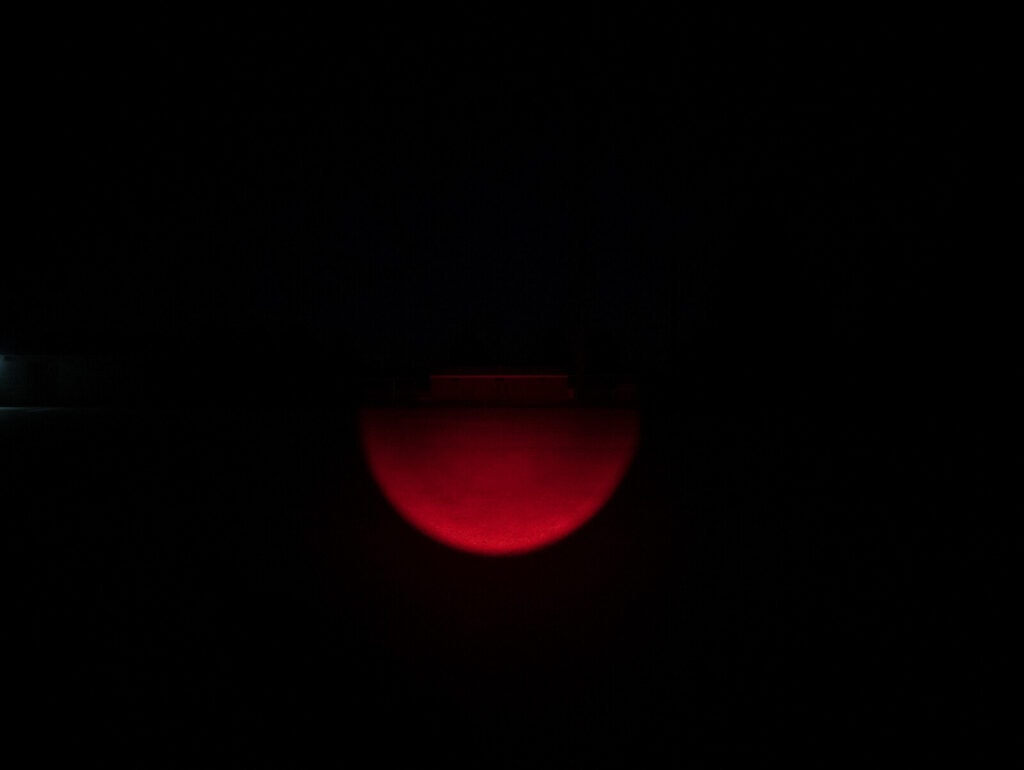
Disclaimer: This flashlight was sent to me for review at no cost by Cyansky. I have not been paid to review, nor have I been holding back on problems or defects.
Note: the H5GT has been updated. The one we reviewed was the earlier version with a 1-minute turbo timer. The newer version has this timer removed, and reduces its output in a more gradual way.
Final Verdict
Pros
- Revolutionary white+color switching mechanism
- Well regulated output
- Super simple dual-switch UI
- Great build quality
Cons
- Thermal regulation kicks in too soon
- USB-C charging on the battery, not the flashlight
Explanation on star ratings:
1: Avoid: a match would be a better choice – 2: Poor: significant defect or issues; almost unusable – 3: Average: some defects or issues; but still usable 4: Good: recommended (minor issues) – 5: Great: highly recommended

4.5 stars: ★★★★⋆
While our star rating provides a reliable indicator, we encourage you to read the full review to make an informed decision based on your own needs and preferences.
The “world’s first” rotating reflector cup design to switch between two different LEDs is really impressive and works just as well in real life as you’d hope. I’ve never been a fan of most color-switching mechanisms (lens filters, LED modules), but this… this is sweet. I can switch between white and red in less than a second without making any design sacrifices. Sure, there are a couple of things I would change: I think the thermal regulation kicks in a bit too soon. And I’d like to see USB-C charging built into the flashlight, not the battery – but maybe I’m just being lazy and not wanting to remove the battery to charge it. The Cyansky H5GT’s build quality is excellent and overall, I am really pleased with this flashlight. If you’re in the market for a hunting and/or long-range flashlight, the Cyansky H5GT deserves a serious look.
Note: the H5GT has been updated. The one we reviewed was the earlier version with a 1-minute turbo timer. The newer version has this timer removed, and reduces its output in a more gradual way.
Note 2: This is our second unit, because our first H5GT arrived with a defect, “The e-switch acted like a momentary high and didn’t switch the outputs permanently”.
Buy your Cyansky H5GT here:
The H5GT is available with either a Red, Blue, or Green secondary LED. Make sure you get the correct one.
1lumen selects and reviews products personally. We may earn affiliate commissions through our links, which help support our testing.